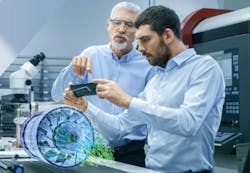Deciphering Digital Twins and Simulation
A key aspect of Industry 4.0 and the developing industrial metaverse concept is digital twin technology. Because of digital twin technology’s growing importance to manufacturing, particularly in commission/testing of new systems before deployment, there’s been a corresponding boom in technologies available to manufacturers.
However, as with any new technology area, the boundaries and definitions can be flexible for several years until it becomes a commonplace fixture. And that’s definitely been the case with digital twin tech, as the lines between it and simulation technologies are not always quite so clear. To get further clarity on this issue, Automation World connected with Michael Sarvo, digital design business development manager, North America, for Rockwell Automation.
AW: What are the key differences between simulation and digital twins?
Sarvo: Digital twins, like simulations, are computer-based models of real-world objects, processes or systems. For us, the distinction is in both the purpose of the models and the way the models are interacted with. We prescribe the use of simulations to predict theoretical performance characteristics of machinery or automation systems by experimenting with input KPIs (key performance indicators), scenarios and system designs. We also think simulations are most useful early in a project lifecycle in support of making critical design choices.
Our take on digital twins most closely relates to the purpose of virtual commissioning. In virtual commissioning, we use dimensional, physics-based modeling to closely emulate machinery and automation systems. These models connect to industrial machinery control systems. The control systems command the digital machinery and receive machinery signals back from the model, just as if the model were real machinery.
AW: When might an OEM or integrator choose one method over the other for commissioning and/or testing a new or upgraded process?
Sarvo: OEMs and system integrators perform simulation modeling in the early to mid-phases of the concept and design process when seeking stakeholder agreement on designs or while there are still questions about the performance characteristics of the designs. Digital twin modeling is used more often when insights are needed from a machine or system while access to that machine or system is not available. This could be because the machinery does not yet exist, or because it is busy in production. The digital twin takes the place of the machinery, empowering engineers to develop, test and debug control systems offline from the real machinery systems.
AW: Are there diverse types of digital twins? If so, what are they and where do they fit into the commissioning and/or testing phase?
Sarvo: Indeed, there are. Digital twin is just another term for computer model. There are different available software technologies that are concerned with modeling different aspects of our reality and to varying degrees of fidelity. Some digital twins replicate automation machinery, which is understandably key to virtual commissioning; however, we may need to consider complex material behaviors or other multi-physics applications that are modeled by separate software tools.
Consider the use of a linear motor being used to move a product between manufacturing operations. A virtual commissioning-focused digital twin may be designed to respond to control signals, provide motion in a 3D model, and report back its motion status to the control system. Another engineering effort may be more concerned with the thermal dynamics of the motor and how to improve component life expectancy, which may require a different type of digital twin.
AW: Virtual commissioning, the use of virtual-simulation technology to commission or test control software with a virtual machine model, is mainly used for early validation of machine code. Can the virtual commissioning component integrate with the digital twin to further streamline the commissioning/testing process?
Sarvo: Yes and this is exactly what Rockwell Automation’s digital twin software (Emulate3D) is designed to do. The digital twins of the machinery and automation systems emulate their real-world counterparts, providing I/O (input and output) connectivity. The machines are modeled to be dimensionally accurate and use physics to handle materials and provide sensor feedback to the control systems.
AW: Can you cite an example of how integrators and OEMs are using digital twins in the commissioning stages of a new or existing plant?
Sarvo: RidgeTech Automation Inc. was recently involved in the design, build and commissioning of multiple material handling systems for two 100,000 square foot vertical farms located in North America. The equipment included automatic storage and retrieval systems (ASRS) and a host of conveyance that moved product through the process from seed to harvest.
The ASRS units were large and heavy, standing over 40-ft. tall and they left no room for error, even during initial startup. Using Emulate3D, RidgeTech was able to virtually commission the systems ahead of the factory startup to prove out the logic and minimize the chance of damage to equipment during the first phases of testing. Having the operator interface running alongside the digital twin application allowed us to address real-life client concerns before the equipment was shipped to site. This process shortened the initial commissioning window and helped reduce delivery time for the complete solution.
AW: What about using digital twins to test changes/improvements to existing equipment operations? Can you provide an example of that?
Sarvo: GA Pet Food Partners engaged in a project with the goals of increasing capacity, flexibility and traceability, while driving down costs, errors and the need for manual intervention in their processes. The original manufacturing process had little automation and their manufacturing execution system (MES) also relied largely on manual interactions. To achieve their goals, GA Pet Food Partners used Emulate3D software to produce a digital twin of their new automation designs and integrated the digital twin with their MES system, allowing them to test, tune and optimize the MES system with all the newly available automation. In addition to achieving their production goals, GA Pet Food Partners noted the project would have taken three to four months longer to complete without this technology.
AW: The pros of digital twins, such as reduced downtimes and predictive maintenance, are often promoted. But what about the downsides to using digital twins for commissioning and/or testing a new or upgraded process?
Sarvo: When it comes to digital twins, there can be a risk to return on investment when engineers go too deep down the rabbit hole. Sometimes people think they want a digital twin of everything without really understanding why. If we seek to build a digital twin in excess of its real purpose, it could become overly complex, require much greater engineering effort and possibly still not provide the insights needed.
Cultivating a workforce with the right skill set is another challenge we see with digital twins. When an organization begins its digital transformation journey, leaders often get caught up in the cost of software tools, but really, the cost of the software is insignificant when you find or grow engineers with the talent to wield it. To be successful, digital twin modeling should not be an occasional part of someone’s work, it should be most of a person’s work. This requires real commitment to change, which can be challenging.



